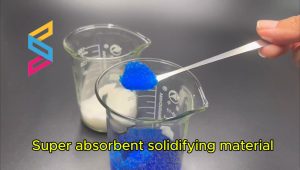Polyacrylate de sodium is a highly versatile superabsorbent polymer, found in everyday products like disposable diapers, pet pads, water-retaining materials for agriculture, and even instant snow. Known for its exceptional absorbency, this polymer can absorb hundreds of times its own weight in water, making it invaluable for a wide range of uses. However, with its widespread application, it’s important to explore the safety of sodium polyacrylate and understand the precautions associated with its handling.
What is Sodium Polyacrylate?

Sodium polyacrylate, a polyacrylic polymer with the formula (C₃H₃NaO₂)ₙ, starts as a powder that turns into a gel when exposed to water. This ability to trap moisture and hold it tightly is what makes sodium polyacrylate perfect for products like diapers, where effective moisture management is critical to avoid leaks and maintain comfort.
Considérations relatives à la sécurité
1. General Safety
Sodium polyacrylate is considered safe under typical conditions of use. Material safety data sheets, which outline the potential hazards of chemicals, confirm that this polymer poses no major health risks. Key points include:
- Contact avec la peau : Sodium polyacrylate is not harmful to the skin. The polymer consists of large molecules that cannot be absorbed through the skin.
- Acrylic Acid Content: During manufacturing, small amounts of acrylic acid may remain in sodium polyacrylate. While acrylic acid can be harmful in large quantities, the residual amount in consumer products, such as diapers, is minimal. Research, including a 2009 study published in the Journal of Toxicology and Environmental Health, supports that the acrylic acid content in these products is far below any hazardous level.
2. Precautions
While sodium polyacrylate is largely safe, there are a few precautions to keep in mind:
- Inhalation Risk: The powder form can cause lung irritation if inhaled. It’s recommended to handle the powder in well-ventilated areas to avoid inhaling dust particles.
- Slippery Surfaces: When in contact with water, sodium polyacrylate becomes slippery, which can create hazards if spilled on floors or other surfaces.
- Environmental Concerns: Sodium polyacrylate can cause clogging in drainage systems if large amounts enter water systems, so it must be disposed of responsibly.
GELSAP: A Trusted Leader in Sodium Polyacrylate Solutions
At GELSAP, we are industry experts in sodium polyacrylate production and application. Our products undergo rigorous testing to ensure they meet the highest safety standards, including strict control of acrylic acid levels to below 300 PPM, ensuring safe and effective use across various industries.
We supply sodium polyacrylate for diverse applications, from moisture control in hygiene products to water retention in agricultural soil. GELSAP’s dedication to quality and safety ensures that our superabsorbent polymers not only perform exceptionally but also adhere to the highest safety and environmental standards.
Conclusion
Sodium polyacrylate is a safe and effective material when handled correctly. Its unique properties make it an ideal solution for many industries, but like any material, it requires proper use and care to prevent potential hazards. GELSAP is proud to be a leading supplier of high-quality sodium polyacrylate, providing safe and innovative solutions to meet your needs.
For more information about our products and services, visit GELSAP’s website or contact us directly.

